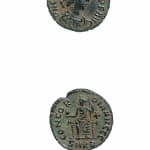Bronze Coin of Emperor Gratian, 367 CE - 383 CE
Bronze
C.7387
Further images
Obverse: DN GRATIANVS PF AVG; Diademed, Draped, and Cuirassed Bust of the Emperor Facing Right Reverse: CONCORDIA AVGGG; Constantinopolis Seated on a Throne Facing Forward, Her Head to the Left,...
Obverse: DN GRATIANVS PF AVG; Diademed, Draped, and Cuirassed Bust of the Emperor Facing Right
Reverse: CONCORDIA AVGGG; Constantinopolis Seated on a Throne Facing Forward, Her Head to the Left, Holding a Globe and a Spear
Flavius Gratianus was the son of the Emperor Valentinian I and his wife Severa. While still a young boy, he was bestowed the rank of Augustus by his father in 367 A.D. When his father died in 375 A.D., he became sole emperor in the West at the age of fifteen. Shortly thereafter, he proclaimed his four-year old brother Valentinian II co-Augustus. After Valens' disastrous defeat by the Goths at Adrianople in 378, Gratian asked Theodosius the Great to become emperor in the East. Though Theodosius' father had been executed after falling out of favor with Valentinian I, Theodosius accepted the job and immediately began to put his wide military talents to strengthen up the East. In 383, the British troops rebelled and invaded Gaul, led by Magnus Maximus. Gratian was not adequately prepared to meet this threat and his soldiers deserted him as well. Gratian had never been very popular with the army because he preferred hunting and sports to leading men into battle. Unable to escape his mutinous army, Gratian was murdered in Lugdunum on August 25th, A. D. 383.
How many hands have touched a coin in your pocket or purse? What eras and lands have the coin traversed on its journey into our possession? As we reach into our pockets to pull out some change, we rarely hesitate to think of who might have touched the coin before us, or where the coin will venture to after it leaves our hands. More than money, coins are a symbol of the state that struck them, of a specific time and location, whether contemporary currencies or artifacts of a long forgotten empire. This stunning hand-struck coin reveals an expertise of craftsmanship and intricate sculptural detail that is often lacking in contemporary machine-made currencies. This coin is a memorial to an ancient emperor passed from the hands of civilization to civilization, from generation to generation that still appears as vibrant today as the day it was struck.
Reverse: CONCORDIA AVGGG; Constantinopolis Seated on a Throne Facing Forward, Her Head to the Left, Holding a Globe and a Spear
Flavius Gratianus was the son of the Emperor Valentinian I and his wife Severa. While still a young boy, he was bestowed the rank of Augustus by his father in 367 A.D. When his father died in 375 A.D., he became sole emperor in the West at the age of fifteen. Shortly thereafter, he proclaimed his four-year old brother Valentinian II co-Augustus. After Valens' disastrous defeat by the Goths at Adrianople in 378, Gratian asked Theodosius the Great to become emperor in the East. Though Theodosius' father had been executed after falling out of favor with Valentinian I, Theodosius accepted the job and immediately began to put his wide military talents to strengthen up the East. In 383, the British troops rebelled and invaded Gaul, led by Magnus Maximus. Gratian was not adequately prepared to meet this threat and his soldiers deserted him as well. Gratian had never been very popular with the army because he preferred hunting and sports to leading men into battle. Unable to escape his mutinous army, Gratian was murdered in Lugdunum on August 25th, A. D. 383.
How many hands have touched a coin in your pocket or purse? What eras and lands have the coin traversed on its journey into our possession? As we reach into our pockets to pull out some change, we rarely hesitate to think of who might have touched the coin before us, or where the coin will venture to after it leaves our hands. More than money, coins are a symbol of the state that struck them, of a specific time and location, whether contemporary currencies or artifacts of a long forgotten empire. This stunning hand-struck coin reveals an expertise of craftsmanship and intricate sculptural detail that is often lacking in contemporary machine-made currencies. This coin is a memorial to an ancient emperor passed from the hands of civilization to civilization, from generation to generation that still appears as vibrant today as the day it was struck.





